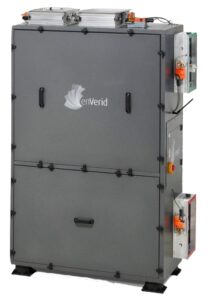
First Commercial ‘Air Scrubber’ Technology Installed in Canada
June 10, 2020 | By HPAC Magazine
The smart scrubber can reduce the need for outside air by 60 to 80%, providing a potential 20 to 30% energy cost savings, reducing pollution and HVAC maintenance, and improving occupant comfort.
The first CO2-reducing air scrubber installed in a Canadian commercial building is now located in the 10th floor space of 100 Sheppard Avenue East in North York, Ont., the same building that is the new home of Canadian mechanical and electrical consulting engineering firm Smith + Andersen, and Footprint, the environmentally-focused arm of the Smith + Andersen Group.

enVerid HVAC Load Reduction (HLR) module.
The air scrubber technology used is the enVerid HVAC Load Reduction (HLR) “smart scrubber” – the AHR Expo Innovation Award-winning technology was developed and provided by enVerid Systems in partnership with O’Dell Associates.
Smith + Andersen and Footprint began exploring the option of an air scrubber installation while planning the relocation of their Toronto teams in 2018. Sustainability was the primary design driver for their new office space, and Manulife, the landlord of 100 Sheppard Ave. E., expressed a shared interest in the potential impact of air scrubber technology.
The Smith + Andersen Group moved their Toronto teams to the new site in the summer of 2019, and the enVerid HLR smart scrubber was installed in late December 2019.
The air scrubber contains an adsorbent material that removes particles, hazardous gasses (including CO2), and harmful chemicals (such as formaldehyde and VOCs) from the air.
Through molecular cleaning, the enVerid HLR smart scrubber can reduce the need for outside air by 60 to 80%, providing a potential 20 to 30% energy cost savings, reducing pollution and HVAC maintenance, and improving occupant comfort.
“Moving into a new office with a new landlord seemed to be the right impetus for Smith + Andersen Toronto to test, first-hand, a technology we have been investigating for (and proposing to) our clients,” explains Smith + Andersen managing principal Kevin Farbridge in a company release.
“This is an HVAC technology that has not yet been used in the Canadian market, so it faces the initial battle of “bleeding-edge” technologies. It seemed right to be testing this technology on ourselves as a proof-of-concept for our clients. We were fortunate to have a forward-thinking landlord, who also saw the potential benefits to their existing building portfolio, and agreed to help support the initiative financially.”
This air scrubbing system is connected to the building’s Desigo building automation system (BAS), provided by Siemens. This connection enables Smith + Andersen and Footprint to monitor air quality, energy savings, HVAC load reductions, and cost savings.




